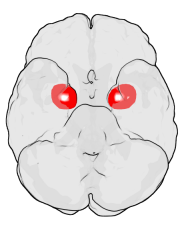
Photo from wikipedia
Introduction: The serotonergic system modulates affect and is a target in the treatment of mood disorders. 5‐HT1A autoreceptors in the raphe control serotonin release by means of negative feedback inhibition.… Click to show full abstract
Introduction: The serotonergic system modulates affect and is a target in the treatment of mood disorders. 5‐HT1A autoreceptors in the raphe control serotonin release by means of negative feedback inhibition. Hence, 5‐HT1A autoreceptor function should influence the serotonergic regulation of emotional reactivity in limbic regions. Previous findings suggest an inverse relationship between 5‐HT1A autoreceptor binding and amygdala reactivity to facial emotional expressions. The aim of the current multimodal neuroimaging study was to replicate the previous finding in a larger cohort. Methods: 31 healthy participants underwent fMRI as well as PET using the radioligand [carbonyl‐11C]WAY‐100635 to quantify 5‐HT1A autoreceptor binding in the dorsal raphe. The binding potential (BPND) was quantified using the multilinear reference tissue model (MRTM2) and cerebellar white matter as reference tissue. Functional MRI was done at 3T using a well‐established facial emotion discrimination task (EDT). Here, participants had to match the emotional valence of facial expressions, while in a control condition they had to match geometric shapes. Effects of 5‐HT1A autoreceptor binding on amygdala reactivity were investigated using linear regression analysis with SPM8. Results: Regression analysis between 5‐HT1A autoreceptor binding and mean amygdala reactivity revealed no statistically significant associations. Investigating amygdala reactivity in a voxel‐wise approach revealed a positive association in the right amygdala (peak‐T = 3.64, p < .05 FWE corrected for the amygdala volume) which was however conditional on the omission of age and sex as covariates in the model. Conclusion: Despite highly significant amygdala reactivity to facial emotional expressions, we were unable to replicate the inverse relationship between 5‐HT1A autoreceptor binding in the DRN and amygdala reactivity. Our results oppose previous multimodal imaging studies but seem to be in line with recent animal research. Deviation in results may be explained by methodological differences between our and previous multimodal studies. HighlightsMultimodal study using 5‐HT1A receptor PET and fMRI.Attempt to replicate previous studies in a larger cohort of healthy controls.Results oppose previous studies but are in line with recent animal research.
Journal Title: NeuroImage
Year Published: 2018
Link to full text (if available)
Share on Social Media: Sign Up to like & get
recommendations!